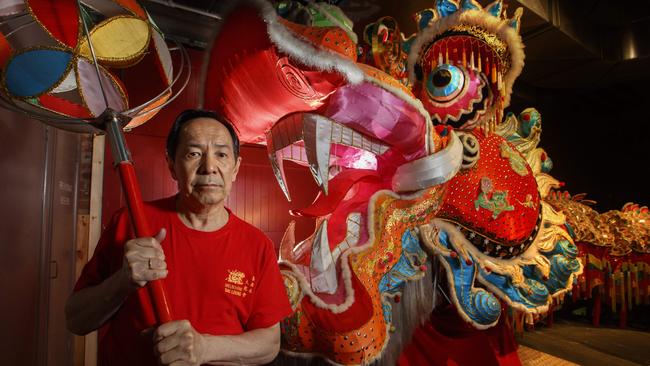Social distancing slays the giant dragon of Melbourne’s Chinese New Year
For almost 70 consecutive years a Dai Loong has paraded through Melbourne’s Chinatown. Until 2021.

Each February, a mythical dragon emerges from its sleeping place at the bottom of the sea and soars into the sky as communities ring in Chinese New Year.
For almost 70 consecutive years, a Dai Loong has wound its way through Melbourne’s Chinatown, thrilling the crowds on Little Bourke Street during the annual big dragon parade.
But as revellers welcome the Year of the Ox, Dai Loong will be stuck at home, sitting on the basement floor of the nearby Museum of Chinese Australian History.
In 2021, Chinese New Year begins on Friday February 12 and runs for 16 days. However, with social distancing in play, it’s impossible to carry the 45m-long dragon and keep a safe distance, says Dragon Society honorary secretary Mark Wang, noting it takes at least eight people to carry the dragon, 34 to operate it and about 50 for a full parade.
Coronavirus, it seems, has slayed the dragon.
“When you’re out on the street you can’t control who’s going to turn up, so we can’t control a street festival,” Mr Wang said.
In China, big dragon parades date back to the Han Dynasty from 206BC to 220AD. In Australia, they go back over a century, says Chinatown Precinct Association vice-president Eng Lim.
“Our first photographic record goes back to 1901 to celebrate the first sitting of Australian parliament in Melbourne,” she said.
While celebrations will still go ahead, albeit at a distance, the dragon parade will be sorely missed at the usually jam-packed, vibrant festival.
“It’s a bit like Australians saying we should have a grand final for the football — but we can’t; we should have a Melbourne Cup but we can’t,” Mr Wang said.

“It’s the most significant activity for Chinese people and it’s about establishing the future path of your next year. If you can’t do that properly it’s difficult for the people.”
Mr Wang, who is also chief executive of the Museum of Chinese Australian History, has paraded the dragon for the past 42 years since 1978 when his father, former Melbourne councillor David Wang, unexpectedly passed away at 57.
“After my father passed the responsibility was bestowed on me by other members of my family,” he said. “I was always the creative person in the family — that was one of the reasons why the museum was formed,” he said, explaining the community needed a home for the dragon.
Finding a new dragon, when one has reached its used-by date, isn’t easy. Years ago he convinced the Chinese company that manufactured lanterns for Melbourne Chinatown to build a new dragon, and was a return customer when that one needed replacement.
Both Mr Wang and Ms Lim are confident Chinese New Year in 2021 will still be a celebration to remember. And as for the dragon, Mr Wang expects a full return for 2022, the Year of the Tiger. “Who knows,” he said. “Next year it’ll probably fly out twice as fast.”








To join the conversation, please log in. Don't have an account? Register
Join the conversation, you are commenting as Logout